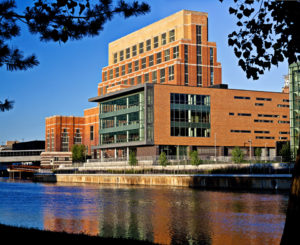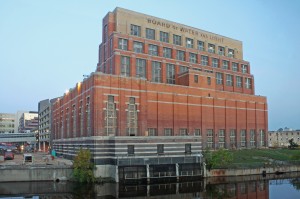A Major Public-private Partnership Invests in an Unprecedented Waterfront Project that Creates Jobs for Michigan
During the past few years, Michigan has been the “poster-child” for the economic crash of 2008. However, in recent months, the media has focused less on Michigan’s hardships and more on its ability to bounce back—thanks in part to concerted efforts by the state’s businesses to be Michigan-centric.
Two such businesses, The Christman Company, a construction-management and real-estate development firm, and Accident Fund Holdings Inc., the 13th largest workers’ compensation insurer in the U.S. and a subsidiary of Blue Cross Blue Shield of Michigan, have been headquartered in Lansing, Mich., for 97 and 100 years, respectively. The firms have had a working relationship for a number of years, so when Accident Fund began outgrowing its downtown office space in 2005, it hired Christman to determine whether to build an addition on Accident Fund’s existing headquarters, build a new structure or renovate another building to meet the insurer’s needs.
PHOTO: Justin Maconochie, www.jmaconochie.com
“It wasn’t really until later in the game that the idea of renovating the vacant Ottawa Street Power Station came into the picture,” remembers Steve Reynolds, vice president of strategic planning and corporate secretary for Accident Fund. “As we did our due diligence around that option to see if it was really viable, it became increasingly appealing to us for a variety of reasons.”
One major reason was Accident Fund’s strong ties to its community and the idea of revitalizing an iconic building along the Grand River that had stood since 1939 but had been mostly abandoned since 1992. Constructing an office building within a decommissioned 9-story power plant was no small feat, especially because the plant had no floors; it was essentially a large, open boiler room.
“Many different organizations and the city had attempted to redevelop the Ottawa Street Power Station, but it just never flew because it was a very different building to renovate,” explains Gavin Gardi, LEED AP BD+C O+M, CFD, AVS, sustainable programs manager and LEED project administrator for Christman. “There were all kinds of beams and structures in the way of easily turning it into a commercial building.”
PHOTO: Gene Meadows and The Christman Company
However, Accident Fund and Christman weren’t deterred by the challenges and by 2008, they moved forward with the renovation. “We thought it was the right thing to do, not only for our business, but also for maintaining our strong commitment to our community, mid-Michigan and the state of Michigan,” Reynolds says. “From the get-go we all agreed to use as many local mid-Michigan- and Michigan-based companies on the project as possible.”
In fact, of the 118 contracts and suppliers that participated in the project, 106 were Michigan-based firms and 54 of those were Lansing-based. The project provided 1 million worker hours overall in an economy where construction jobs, especially, were difficult to find. The project’s local focus and its sheer complexities have made it one of the most unique retrofit projects in U.S. history.


